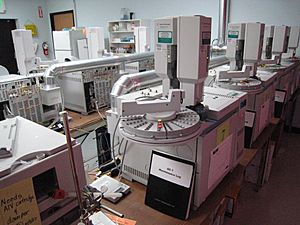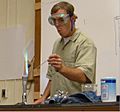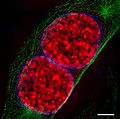Analytical chemistry facts for kids

Analytical chemistry is a branch of chemistry. It tries to analyze chemicals in different things.
Analytical chemistry studies and uses instruments and methods to separate, identify, and quantify matter. A sample job would be trying to see how much zinc is in a piece of brass. In practice, separation, identification or quantification may constitute the entire analysis or be combined with another method. Qualitative analysis finds out what chemical species are in the sample and how much there is of each component in the substance. Components are often separated before this analysis.
Analytical chemistry consists of classical, wet chemical methods and modern, instrumental methods. Classical qualitative methods use separations such as precipitation, extraction, and distillation. Identification may be based on differences in color, odor, melting point, boiling point, solubility, radioactivity or reactivity. Classical quantitative analysis uses mass or volume changes to quantify amount.
Instrumental methods may be used to separate samples using chromatography, electrophoresis or field flow fractionation. Then qualitative and quantitative analysis can be performed, often with the same instrument and may use light interaction, heat interaction, electric fields or magnetic fields. Often the same instrument can separate, identify and quantify.
Analytical chemistry is also focused on improvements in experimental design, chemometrics, and the creation of new measurement tools. Analytical chemistry has broad applications to medicine, science, and engineering.
The first instrumental analysis was developed by Robert Bunsen and Gustav Kirchhoff who discovered rubidium (Rb) and caesium (Cs) in 1860.
Images for kids
-
Gustav Kirchhoff (left) and Robert Bunsen (right)
-
The presence of copper in this qualitative analysis is indicated by the bluish-green color of the flame
-
An accelerator mass spectrometer used for radiocarbon dating and other analysis
-
Separation of black ink on a thin-layer chromatography plate
-
Fluorescence microscope image of two mouse cell nuclei in prophase (scale bar is 5 µm)
-
US Food and Drug Administration scientist uses portable near-infrared spectroscopy device to detect potentially illegal substances
See also
 In Spanish: Química analítica para niños
In Spanish: Química analítica para niños










